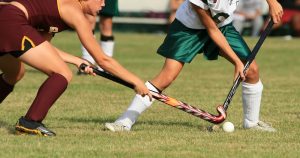 Field hockey, like many other sports requires a combination of speed, agility and endurance. It is this continuous running coupled with rapid side to side movements and changes in pace that are responsible for many of the lower limb and foot injuries frequently seen in hockey players, and often seen at my FootDr podiatry centres.
Field hockey, like many other sports requires a combination of speed, agility and endurance. It is this continuous running coupled with rapid side to side movements and changes in pace that are responsible for many of the lower limb and foot injuries frequently seen in hockey players, and often seen at my FootDr podiatry centres.
There are two main classifications when it comes to hockey injuries; acute, which occur suddenly during activity, and overuse which result mostly through repetitive actions where incorrect alignment and posture of the lower limbs or feet causes injury. The repetitive actions of hockey coupled with foot or knee joint misalignment increases stress on surrounding muscles, tendons and bones therefore making you more prone to injury.
Along with alignment factors, the artificial turf in which hockey is commonly played on can be a contributing factor to many overuse injuries, as like running on road, shock absorption is decreased on this surface. Therefore shoes and insoles with good support and cushioning properties are very beneficial in reducing the chance of injury.
Common Hockey Injuries
Acute Injuries
- Inversion ankle sprains: (twisting your ankle) Are most often linked with quick side to side movements and occur when the structures on the outside of the ankle joint are stressed to the point of tearing. People who have weakness in the ankle complex or a history of sprains are more susceptible to this injury. Ankle strapping definitely helps.
- Fractures of the foot:
Overuse Injuries
- Shin Splints
- Generalised pain most commonly located at the bottom 5cm of the inside section of the leg along the shin bone, however it can occur anywhere on the front of the shin bone.
- This area will be tender with pressure and is usually most painful at the start of activity with pain decreasing as the leg muscle warm up.
- In hockey shin splits are frequently caused by poor footwear, hard-soled shoes (hockey cleats), incorrect alignment through the feet or knees and muscular imbalances.
- Plantar Fasciitis (Heel Pain)
- Pain in the heel which is worst in the mornings with first steps of after resting for a period of time.
- Plantar fasciitis is one of the most common foot injuries, occurring mainly due to poor foot biomechanics. A sudden increase in activity duration or intensity, along with worn-out footwear is also common causes.
- Achilles Tendonitis
- This condition occurs when the Achilles tendon and its covering sheath become inflamed or when tiny tears in the tendon fibers arise.
- Common symptoms include; stiffness in the morning or during activity warm up, tenderness with pressure, visual thickening of the tendon or small nodules within the tendon which may be felt by running fingers either side of the Achilles.
- This condition arises due to numerous factors, including; tight calf muscles, overtraining, excessive pronation (rolling in of feet), poor or incorrect footwear and repetitive quick propulsive movements.
- Iliotibial Band Friction Syndrome (ITB)
- Frequently referred to as runner’s knee, ITB syndrome is an overuse injury causing a sharp ache just above the outside section of the knee joint.
- The pain arises due to repetitive ‘flicking’ of the ITB over the bony prominence located just above the knee joint line. This flicking movement occurs as the knee moves through its normal range of motion while running.
- Frequent causes include; poor biomechanics especially rolling in at the feet and knee joints, weakness of the inner quadriceps muscle (vastus medialis obliques), weakness of the gluteal and hip muscles, poor worn-out footwear and endurance running.
- Hamstring Injuries
- In hockey the hamstrings are constantly activated due to the slight flexed position players assume while holding the hockey stick. Quickly moving from this flexed position into a sprint increases strain of the hamstring complex.
- Causes of sprains include; poor running biomechanics, muscle imbalance between the quadriceps and hamstrings, improper warm up, lower back or gluteal weakness and wet playing surfaces such as the artificial turf hockey is played on.
As you can see, chronic injuries far outweigh acute injuries, however chronic injuries will stop you playing and enjoying hockey if you do not look after the problem. This is why you should see a podiatrist as soon as possible when you notice any lower limb or foot pain.


